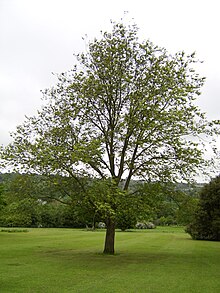Ulmus wallichiana
| Ulmus wallichiana | |
|---|---|

| |
| Ulmus wallichiana, Withdean Park, Brighton. | |
| Scientific classification | |
| Kingdom: | Plantae |
| Clade: | Tracheophytes |
| Clade: | Angiosperms |
| Clade: | Eudicots |
| Clade: | Rosids |
| Order: | Rosales |
| Family: | Ulmaceae |
| Genus: | Ulmus |
| Subgenus: | U. subg. Ulmus
|
| Section: | U. sect. Ulmus
|
| Species: | U. wallichiana
|
| Binomial name | |
| Ulmus wallichiana Planch. | |
| Synonyms | |
| |
Ulmus wallichiana Planch., the Himalayan elm, also known as the Kashmir elm and Bhutan elm, is a mountain tree ranging from central
Description
The Himalayan elm grows to 30 m tall, with a broad crown featuring several ascending branches. The bark of the trunk is greyish brown and longitudinally furrowed. The leaves are
-
Ulmus wallichiana, from Illustrations of the Forest Flora of North-West and Central India, 1874
-
Samarae
Pests and diseases
The tree has a high resistance to the fungus
Cultivation and uses
Endemic to an impoverished region with no fossil fuel resources, U. wallichiana is heavily lopped for firewood, and also for fodder, leaving it in danger of extermination in some areas.[8][9] Elsewhere however, it has been deliberately planted near villages and farmhouses. Recognizing its predicament, efforts have been made in India to conserve the tree by drying the seeds and placing them in refrigerated storage.[10] A species of considerable commercial potential, research has also been undertaken into optimal propagation methods.[11][12][13]
The tree was first introduced to the West in the 1920s, with the arrival of a specimen at the
U. wallichiana is grown in several arboreta in the UK, but by far the largest number is held by
In North America, the species is represented only by two specimens at the U.S.
There are no known cultivars of this taxon, nor is it known to be in commerce.
Etymology
The tree is named for the Danish botanist Nathaniel Wallich.
Subspecies and varieties
There are two subspecies, wallichiana and xanthoderma, and a variety tomentosa identified by Melville & Heybroek,[3] distinguished largely by variations in pubescence of the leaves and young stems.
Notable trees
An old Ulmus wallichiana (bole girth 24 ft) stands in the Graveyard of Trari Baba near the town of Shamlai, Pakistan.[18] A finely-grown old specimen (2012) in the Kullu Valley in Himachal Pradesh is listed as one of the landmark trees of India.[19]
Hybrids
Hybrid cultivars
U. wallichiana was crossed with the
Accessions
- North America
- U S National Arboretum, Washington, D.C., US. Acc. nos. 76238, 76246.
- Europe
- Beemster Arboretum, Netherlands. Descendant of P39 (original graft S.G.A. Doorenbos) used in Dutch Elm Breeding programme.
- d.b.h.[22]Other locations include some 60 trees in Crespin Way, Hollingdean; Withdean Park (2 trees).
- Grange Farm Arboretum, Sutton St James, Lincolnshire, UK. Acc. no. not known.
- Royal Botanic Gardens, Wakehurst Place, UK. Acc. no. 1992–2028, wild collected in western Nepal.
- Sir Harold Hillier Gardens, Hampshire, UK. Acc. nos. 1977–2345, 1977–5321, 1977–6072.
- Wijdemeren City Council, Netherlands. Elm Arboretum, Brilhoek Nederhorst den Berg, descendants of P39 (and P296 = U. w. ssp. xanthoderma) planted in 2019 next to each other. Tree number: 112793
- Australasia
References
- . Retrieved 19 November 2021.
- ^ "Herbarium specimen - L.1582443". Botany catalogues. Naturalis Biodiversity Center. U. wallichiana leaves specimen (Heybroek); Zuiderpark, The Hague (1959); "Herbarium specimen - L.1582444". Botany catalogues. Naturalis Biodiversity Center. U. wallichiana leaves specimen (Heybroek); Zuiderpark, The Hague (1962); "Herbarium specimen - L.1582442". Botany catalogues. Naturalis Biodiversity Center. U. wallichiana leaves specimen (Heybroek); Waalsdorperweg, The Hague (1959); "Ulmus erosa, samarae and new leaves (Kumaon district, 1824) K001119688". Herbarium catalogue. Board of Trustees of the Royal Botanic Gardens, Kew. Retrieved 17 October 2016.
- ^ a b Melville, R. & Heybroek, H. (1971). The Elms of the Himalaya. Kew Bulletin Vol. 26(1). Royal Botanic Garden Kew, London
- S2CID 42980569.
- S2CID 7520439.
- ^ Mittempergher, L; Santini, A (2004). "The history of elm breeding" (PDF). Investigacion Agraria: Sistemas y Recursos Forestales. 13 (1): 161–177.
- ^ a b Heybroek, Hans M. (1957). "Elm breeding in the Netherlands". Silvae Genetica. 6 (3–4): 112–117.
- ^ Maunder, M. (1988). Plants in Peril, 3. Ulmus wallichiana (Ulmaceae). Kew Magazine. 5(3): 137–140. Royal Botanic Garden, Kew, London.
- .
- ^ Phartyal, S., Thapliyal, J., Nayal, J. & Joshi, G. (2003). Seed storage physiology of Himalayan Elm (U. wallichiana): an endangered tree species of tropical highlands. Seed Science & Technology Vol. 31. International Seed Testing Association (ISTA), Bassersdorf, Switzerland. [1]
- ^ Thakur, I.K. (1999). Vegetative propagation studies in ELM (Ulmus wallichiana planch)- A tree of high economic value. Journal of Non-Timber Forests Products, 6(1/2): 71–73. Department of Tree Improvement & Genetic Resources, Dr. Y. S. Parmar, University of Horticulture & Forestry, Nauni, Solan 173230, H.P., India.
- .
- ISBN 978-0881927382
- ISBN 9789050112819
- ^ Ulmus wallichiana, Longhill School, Rottingdean
- ^ Hillier & Sons (1977). Catalogue of Trees & Shrubs. Hillier, Ampfield, UK.
- ^ Hillier & Sons Sales inventory 1962 to 1977 (unpublished).
- ^ Ulmus wallichiana, Trari Baba graveyard, Shamlai, Pakistan; researchgate.net
- ^ 'Landmark trees of India': Ulmus wallichiana, Kullu Valley, Himachal Pradesh; outreachecology.com
- ^ Heybroek, Hans M. (1983). Burdekin, D.A. (ed.). "Resistant elms for Europe" (PDF). Forestry Commission Bulletin (Research on Dutch Elm Disease in Europe) (60). London: HMSO: 108–113.
- ^ "List of plants in the {elm} collection". Brighton & Hove City Council. Retrieved 23 September 2016.
- ISBN 978-1-873580-61-5.
- ^ RBGV (Melbourne) Elm list



